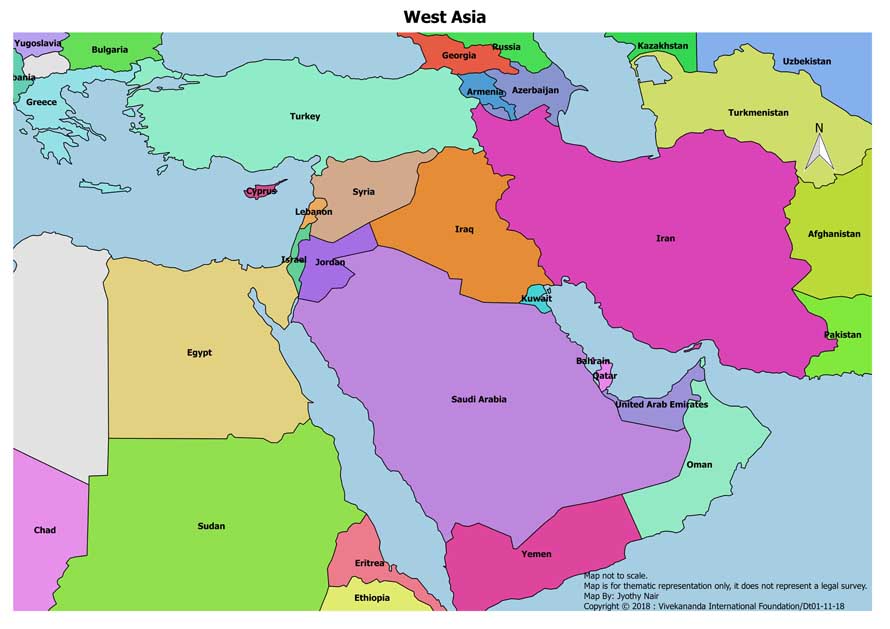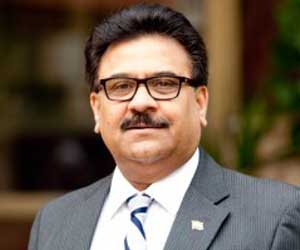Abstract
West Asia continues to be fraught with uncertainty and mixed diplomatic discourse. On the one hand US-Iran spat continues but showed the signs of fissure in the so called “Alliance of the Willing” as UK released the detained Iranian Tanker Grace I (renamed Adrian Darya I) despite US protests and efforts to stop the ship that was supposedly destined for Syrian ports. However, Iranians said that Syria was not the desination which even now is doubted as it progresses towards its declared destination. India meanwhile requested that indian origin crew be taken off the US black list since it was no fault of theirs.
Meanwhile President Trump did not dismiss holding talks but the Iranians maintained that dialogue could only take place if the US lifts all sancions against them. French continue to discuss some way forward with Iran by keeping the US in the loop. They even invited the Iranian Foreign Mninster Javad Zarif to France on the sidelines of the G7 Summit which did generate speculation whether the US and Iran were about to break the impasse.
United Arab Emirates (UAE) maintained that dialogue with Iran will be the way forward and carried on with their bilateral track not necessarily to the liking of the Saudis but this was appreciated by Iranian President Rouhani. Even though Emirati Crown Prince Mohammad Bin Zayed (MBZ) joined his Saudi counterpart Mohammed bin Salman (MBS) at the first ‘Halal Bar’ in Jeddah (an indication of social reform in Saudi) some fissures became apparent on the Yemeni theatre as UAE decided to scale down its military presence from there. This was further complicated when the Yemeni militias supported by UAE attacked and were attacked by the Saudi backed regime forces whom UAE called “Terrorist militias”. UAE termed its direct and precise airstrikes a defencive act while Yemen President Hadi, based in Riyadh, expressed his shock and disma at UAE strikes in temporary capital Aden. It appears in this losing war both the Saudi and UAE leadership want to protect their protégé and keep their reputation intact even if going on the opposing sides that will create further confusion in the coalition as Houthis supported by Iranians continue to mount drone and missile attacks against Saudi targets.
Meanwhile cries by human rights activists and the western countries calling for cessation of hostilities and humanitarian disaster became vociferous. At the same time Morocco accused UAE supporting the Polisario Front for not supporting them against Qatar in the blockade. And the Libyan Govt of PM Serraj accused them of carrying out airstrikes in favour of General Khalifa Haftar. Some of the regional observers are unable to size up the UAE power-posturing across the Middle East. As for India , PM Modi visited UAE on his 3rd visit and was conferred upon the highest ‘Sheikh Zayed Medal’. First ever Bahrain visit of PM also was in the context of strategic projects and bilateral cooperation.
As the Persian Gulf crisis looms large the Isrealis took on the Hezbollah and other Iranian backed militias in Iraq, Syria and Lebanon partially to keep the Iranian proxies targeted and partly to shore up Netanyahu’s popularity shored up for the forthcoming elections. Gaza remains on the cinders in the meantime .The tension between Beirut and Tel Aviv rose as the Isreali drones attacked Hezbollah in Southern Lebanon. The Hezbollah leader Nasrallah claimed that their response was “Decided” and that “Israel will pay a price” . The two had last fought in 2006.
Sudan crisis appears to be subsiding with the signing of the Transitional Government Agreemnt with the military and civilians agree to a powersharing formula for three years to stabilize the situation.
Israel attacks targets in Iraq, Lebanon and Syria
On 24 August 2019, Israel carried a series of attacks in Iraq, Syria and Lebanon. In Syria, the Israel Air Force conducted air raids in Aqraba, southeast of Damascus allegedly to prevent drone attacks in northern Israel by Quds Force. Israel has claimed that the usage of Kamakaze drone by Iran and its allies that are set to explode on their targets is a new tactic. In another attack on a Hezbollah base in Syria, two Hezbollah operatives were killed. In Iraq, Israel used drones to target areas and military sites belonging to Hashad al-Shaabi Force or Popular Mobilisation Forces (PMF), a Shiite group working under the authority of Iraqi government and backed by Iran. Iraqi Intelligence has claimed that the Israeli attack was conducted from the Kurdish areas dominated by Syrian Democratic Force (SDF) due to Israel’s lack of range to attack targets in Iraq.
Israel also attacked Popular Front for Liberation of Palestine (PFLP) base in Qusaya and carried out drone attacks in Beirut against Hezbollah targets. There were no reported casualties in the attacks in Lebanon. The General Secretary of Hezbollah, Hasan Nasrallah called it an attack with suicide drone and claimed it as clear violation of rules of engagement established after 2006 Israel-Hezbollah war. Israel has claimed the series of attacks were carried to thwart Iran’s plans for equipping its allies with precision-guided missiles, drones and sophisticated weapons.
Southern Transitional Council (STC) takes over Aden
The separatists from the Southern Transitional Council (STC) took control of the coastal city of Aden in mid-August. The STC formed by the Southern movement had allied with the Saudi and Emirati coalition in their fight against the Houthi movement. During Houthis’ attempts to take over Aden which is the provisional capital under the internationally recognized government of Abdrabbuh Mansur Hadi, the Southern movement combined forces with the government forces and the Saudi led coalition. However rift had emerged since 2017 between the Hadi led government based in Aden and the Southern movement after Hadi removed the Southern movement leader Aidarous al-Zoubeidi as the governor of Aden. It led to protest rallies in the southern region demanding an independent state. The clash between the pro-government forces and the southern separatists during the four days of fighting in mid-August resulted in deaths of 40 people and 260 people injured. The Hadi led government has blamed UAE backing the STC which it fears would lead to dismemberment of the state.
Gibraltar released Iranian oil tanker
On 15 August 2019, the government of Gibraltar released the Iranian oil tanker, Grace I which has been at the centre of an international dispute between Iran and Britain since the ship’s seizure on 4 July 2019 on the charges of Iran violating European Union sanctions and supplying oil to Syria. Iran in response seized British oil tanker, Stena Impero for violating maritime rules on 19 July 2019.
The flare-up in the conflict between Britain and Iran appears to have subsided after the government of Gibraltar agreed to release the Iranian tanker. The Gibraltar government and the Supreme Court refused to concur with the requests made by the US authorities to extend the detention. Gibraltar announced that the decision to free the vessel was made after receiving written assurances from Iran that it would not proceed to Syria.
Indian Prime Minister’s visit to UAE and Bahrain
Indian Prime Minister Narendra Modi visited the UAE on 23-24 August 2019 and Bahrain on 24-25 August 2019. The visit by the Indian Prime Minister marks the first visit to the UAE and the West Asian region after coming back to power for a second term in May 2019. The Indian Prime Minister during his speech in Abu Dhabi noted that tolerant UAE and secular India are powerful forces for global peace and harmony. The Indian Prime Minister was awarded with UAE’s highest civilian award, i.e. the Order of Zayed for his pivotal role in building and strengthening strategic ties between both states. He also launched RupPay payment mechanism in UAE and signed MOU to launch RuPay payment mechanism in Bahrain. Modi also received Bahrain’s highest civilian award, King Hamad Order of the Renaissance by the King of Bahrain, Hamad bin Isa Al Khalifa and signed three MOUs in the sphere of collaboration in International Solar Alliance (ISA), cultural exchange and space technology between Indian Space Research Organization (ISRO) and National Space Science Agency.
The Military Council and the opposition coalition in Sudan sign transitional government agreement
On 17 August 2019, Sudan’s main opposition coalition group, Alliance for Freedom and Change representative Ahmed Al-Rabie and Deputy Chief of the ruling Transitional Military Council (TMC), Mohamed Hamdan Dagalo signed a landmark agreement to determine the process of power-sharing and transition to a civilian-led government in the near future. The agreement envisaged creating a joint military and civilian sovereign council to oversee governance for three years until elections are held. The sovereign council would be composed of five members appointed by the TMC and five appointed by the opposition coalition and one agreed by the two governing bodies.
The head of the 11 members sovereign council would be first appointed by the TMC that would hold office for 21 months; subsequently, the head would be appointed by the opposition coalition that would hold office for 18 months. The agreement also drew the provisions of the cabinet, the legislative body and an independent investigation body to study the atrocities committed by the security forces on the protestors. The newly appointed Prime Minister, Abdalla Hamdok appealed to the US to remove Sudan from the list of states sponsoring terrorism.
Iranian Foreign Minister’s visit to France
Iranian Foreign Minister Javad Zarif met with French President Emmanuel Macron and Foreign Minister Jean-Yves Le Drian to discuss on the regional issues, JCPOA and the missile programme on the occasion of the meeting of the G7 members namely Canada, France, Germany, Italy, Japan, Britain and the US in Biarritz, France. The invite by the French President came as a surprise which was done in consultation with the US. France’s attempts are seen as measures to dilute tensions between the US and Iran and salvage the 2015 nuclear agreement.
(The paper is the author’s individual scholastic articulation. The author certifies that the article/paper is original in content, unpublished and it has not been submitted for publication/web upload elsewhere, and that the facts and figures quoted are duly referenced, as needed, and are believed to be correct). (The paper does not necessarily represent the organisational stance... More >>











Post new comment